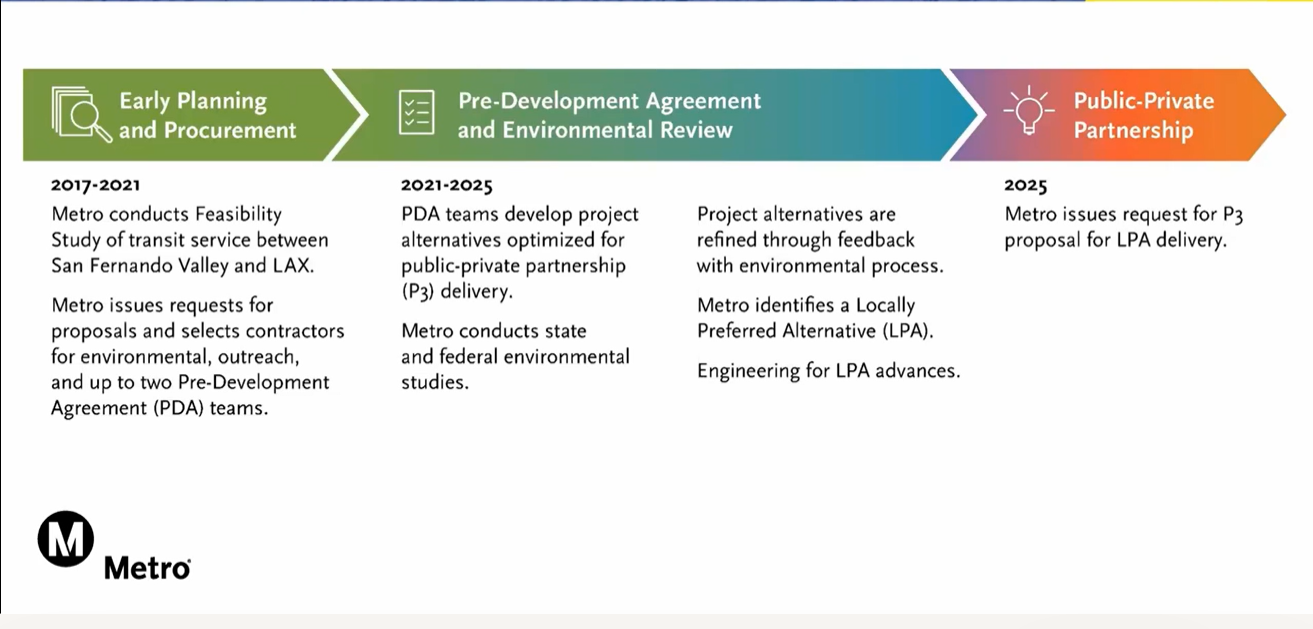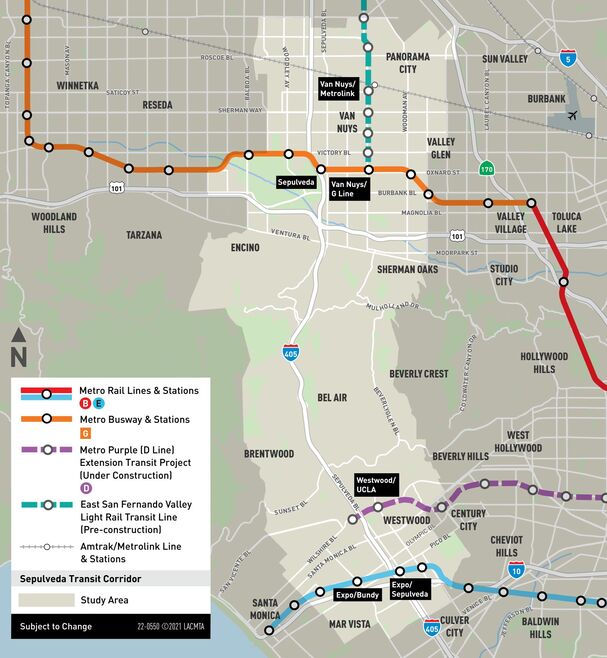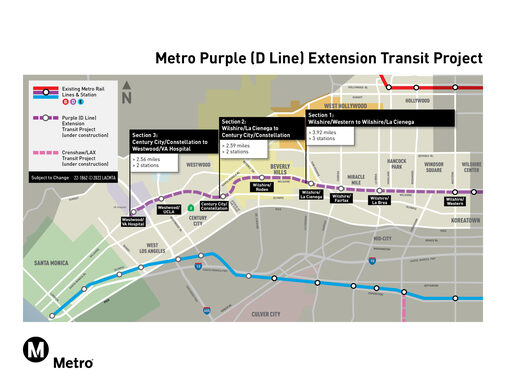Have questions about the Sepulveda Transit Corridor project? Take a look at our most frequently asked questions.
What is the Sepulveda Transit Corridor?
Metro’s Sepulveda Transit Corridor Project will link the San Fernando Valley to the Westside (and eventually to LAX) via a rail connection. The relentless traffic congestion on the 405 Freeway through the Sepulveda Pass demonstrates the significant demand for that travel connection, and the commuting public is long overdue for this much needed transportation network improvement.
What Are the Different Proposals foR the SEpulveda Transit Corridor?
There are five alternative alignments being considered by LA Metro. See the chart and maps below for more information and visit our Resources Page or the official Metro Project Page for more detailed information.
WHAT IS THE DIFFERENCE BETWEEN HEAVY RAIL AND MONORAIL?
Please refer to Metro's Interactive Story Map describing the different technologies. Also see our Resources page for more perspectives.
Why IS it necessary to have aN ON-CAMPUS ucla/ Westwood Village station?
As Los Angeles’ premier public research university (and the #1 public university in the country for years running), with a world class medical center and UCLA Health system hospital, UCLA should be easily accessible to all the people of Los Angeles. A Metro station on the UCLA campus is the best way to accomplish that for our city. High quality rail connections to both east/west (via Purple Line transfer) AND north/south (on the Sepulveda Transit Corridor Line) are necessary to fully actualize the university’s benefit for the region, and to provide the transit connectivity that is essential to a fully functional and successful transportation network. UCLA also provides affordable access to an abundance of cultural institutions, including the Hammer Museum, the Fowler Museum, Royce Hall, and Pauley Pavilion.
How will the Sepulveda Transit Corridor Contribute to reducing vehicular traffic?
Reducing vehicular traffic congestion on the Westside, removing a significant number of vehicles from the 405 Freeway by giving those travelers a convenient and reliable rail option directly to UCLA, Westwood, and the Purple Line, and while maintaining and even increasing the vibrancy and accessibility for number of people who travel come to the Westside our area, is something we should strive for and can achieve together. Regardless of the transit mode that is eventually selected, whether heavy rail or monorail, the Sepulveda Line must have a station on the UCLA campus and also must connect directly to Metro’s Purple Line, as it continues on to the Expo Line and eventually to LAX. The critical decisions about the Sepulveda Transit Corridor project should not be made with a short-term lens, but rather must take into consideration what will best serve the people of Los Angeles and Southern California over the long-term, well into the next century.
What will the new Commute times be with the Sepulveda Transit Corridor?
The estimated Metro travel times between the San Fernando Valley and UCLA/Westwood for the various proposals are notable in that the direct subway connection from Van Nuys/Ventura to the center of the UCLA campus would be approximately a 16-minute ride. Under the monorail version, the trip from the Valley just to the 405/Wilshire interchange area, where the monorail would stop, would take up to 27 minutes. The additional connector ride (via a yet undetermined mode) from the monorail stop at the 405 into the Village or up to the UCLA campus would likely add another 15 minutes to the trip, not to mention any waiting time for the connecting ride. People often optimize for travel times. Selecting a slower, less connected project will result in significantly decreased ridership on the Sepulveda Line, which would negatively impact the financial viability of the project. That is why a one-seat (direct, no transfer) ride to a station on the UCLA campus is so important to the Los Angeles region.
What are the next steps in metro's environmental review process?
Metro received over 2,000 comments as part of the scoping process that closed on Friday, February 11, 2022. Metro released a summary report on the scoping process in June 2022, and will schedule community outreach meetings to share the report with the community and gather more input.
The next step will be for Metro to prepare a Draft Environmental Impact Report (DEIR) and its federal equivalent. Following the DEIR, the Metro Board will consider a Locally Preferred Alternative (LPA).
Once the LPA is selected, Metro will prepare a state Final Environmental Impact Report (FEIR) and a federal Environmental Impact Statement (EIS). In addition, a Record of Decision (ROD) by the Federal Transit Administration, will be prepared.
After certification of the FEIR, EIS and ROD, Metro will move to the final design and construction phases.
Metro’s stated projected opening date range is 2033 to 2035.
The next step will be for Metro to prepare a Draft Environmental Impact Report (DEIR) and its federal equivalent. Following the DEIR, the Metro Board will consider a Locally Preferred Alternative (LPA).
Once the LPA is selected, Metro will prepare a state Final Environmental Impact Report (FEIR) and a federal Environmental Impact Statement (EIS). In addition, a Record of Decision (ROD) by the Federal Transit Administration, will be prepared.
After certification of the FEIR, EIS and ROD, Metro will move to the final design and construction phases.
Metro’s stated projected opening date range is 2033 to 2035.
HOW WAS THE STC4ALL COALITION FORMED?
The STC4All coalition was formed in December of 2021 by neighborhood groups, community organizations, educational entities, and individual supporters from across Los Angeles that want to ensure the Sepulveda Transit Corridor is accessible and equitable for all Angelenos. The coalition is focused on building and growing an advocacy network around two central goals:
- Ensuring the Sepulveda Transit Corridor Metro line includes a direct on-campus UCLA station; and
- Ensuring the Sepulveda Transit Corridor Metro line includes a seamless connection to the Purple Line at Westwood Village.
what's the difference between the stc and the purple line extension?
The Sepulveda Transit Corridor is a proposed north-south rail project that will run between the San Fernando Valley and the Westside (and eventually to LAX).
In contrast, the Purple/D Line Extension project is a east-west subway extension project that will eventually link the Westside to the D Line’s current terminus near Downtown LA. The project is being built in three stages, with service to the Westwood Village station scheduled to begin in 2027. Learn more about the Purple Line Extension here.
does the coalition have a preference between heavy rail and monorail?
Overall, the coalition does not have a position on the mode of transportation used (heavy rail vs. monorail), as long as the STC project includes an on campus UCLA station and a direct Purple Line connection at Westwood Village. While the coalition as a whole does not favor certain project alternatives, some coalition members have voiced their specific preferences or concerns regarding the project during Metro’s public scoping process. Learn more about individual coalition members’ preferences and specific comments on our Resources page.







